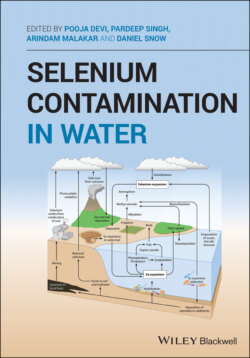Читать книгу Selenium Contamination in Water - Группа авторов - Страница 26
2.3 Species of Selenium
ОглавлениеBioavailability of Se species is mainly governed by the distribution of Se in particle (insoluble Se species) and dissolved phases. Selenate (SeO42−) and selenite (SeO32−) are the soluble inorganic forms of Se, among which selenate (SeO42−) is considered the most soluble Se form (~90–95% of soluble se in arid agriculture water) (Masscheleyn et al. 1990). However, Se(0) and Se(‐II) are usually insoluble until available in suspended form. A quantitative relation between particulate and soluble Se species can be depicted in terms of distribution coefficient (Kd = Se per unit mass particulate material/Se per unit volume water, in units of equivalent) (IAEA 1994). This is frequently used to calculate the sorption behavior of Se in soil. Thus, accumulation of Se in animals is mainly in the particulate form as compared with that of the amount taken up from water (Luoma et al. 1992). Biogeochemical transformation reactions govern the Se concentration based on interaction between soluble and particle Se species. Concentration of Se in the food web is dependent on efficiency of transformation from dissolved to particulate Se by microorganism and determined in terms of μg of Se/g. Nakamaru et al. (2005) have reported that Kd of Se is 600–800 l/kg for Japanese agricultural andosols.
Existence of Se species, along physiological pH and within permissible redox potential range of water, is shown in the Pourbaix diagram for Se (Figure 2.1; Mayland et al. 1989). In the Figure 2.1 the highlighted part shows the natural soil conditions. Se(0) is insoluble and on oxidation can be converted to higher oxidation state Se(IV) and Se (VI) species. In natural soil conditions, selenate (SeO42−; the most toxic form of Se) and selenite (SeO32−) are the soluble oxyanions that can be transformed into elemental Se(0) where organic matter and microbial species participate in this process. Selenate (SeO42−) is most soluble form of Se, with low adsorption and precipitation capacity, which predominates in alkaline and high redox potential soil conditions (Fordyce 2007). On the other hand, selenite (SeO32−) occurs in neutral and acidic soil conditions (Kabata‐Pendias 2011) with moderate redox potential range (Milne 1998). Se(‐I) and Se(‐II) species are stable in the form of metallic selenides and organometallic compounds (e.g. DMSe dimethylselenide) under strong reducing conditions. These species are insoluble and immobilize unless available in suspended form. Most of the Se(‐II) species are toxic in nature; however, it has been stated that the toxicity of gaseous DMSe is lesser (~500–700 times) than SeO42− (Calderone et al. 1990; Stork et al. 1999). Figure 2.1, suggest that HSe− doesn't exist in natural conditions; however, in water it gets converted to H2SeO3, a highly oxidizing selenic acid. Besides these inorganic Se species, various organic selenides in the presence of microbial species present in natural conditions in soil and water bodies (Cutter 1982; Lenz et al. 2006).
For transportation of selenium aquatic bodies play important role (Cutter and Bruland 1984), therefore it is important to know the species present in the aqueous medium.
The scheme suggests that selenite is thermodynamically unstable and converted to selenate under well‐aerated alkaline water, but the process is slow, i.e. kinetically this transformation is not accomplished in ambient surface water until microbes are not involved. In water with high redox potential, selenate is the major species, as redox potential decreases in sediment–water interface and in sediment pore water selenite is the major species. Selenite shows high adsorption capacity over mineral sites such as Fe and Mn hydroxide minerals, etc. as compared to selenate. As a result Se concentration in aqueous phase decreases dramatically irrespective of the redox potential of the system. Other than these soluble inorganic Se species occur in highly reducing waters by reaction of Se compounds with reduced S moieties. In nature, selenate is the major species in irrigation drain water that inserted to wetland (Presser and Ohlendorf 1987; Zhang and Moore 1996). Selenite is widespread species in industrial waste associated particularly with fossil fuel (Cutter and San Diego‐McGlone 1990). Organic Se is available wherever it is recycled (Takayanagi and Wong 1984). In the presence of microbial activity soluble selenite and selenate can be reduced to undissolved elemental Se, so in highly reducing waters, selenite and selenate are not encountered. Insoluble Se species are very less reactive and thus are less significant from a quantitative point of view in aerated water. Besides inorganic Se species various other organic Se species have been assumed to present in small fractions of the entire Se concentration in well aerated surface water. However, their contribution is considered to be negligible for the overall Se cycling, but may have possible implications for uptake by aquatic organisms and may have ecotoxicity effect on them.
Figure 2.1 E‐pH diagram of selenium in soils
(Source: adapted from Mayland et al. 1989 with permission from John Wiley and Sons).
